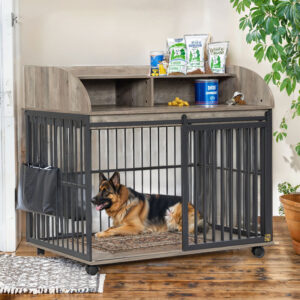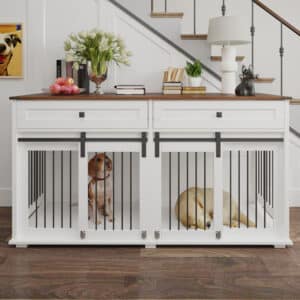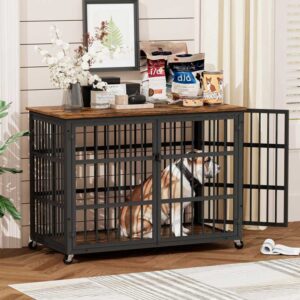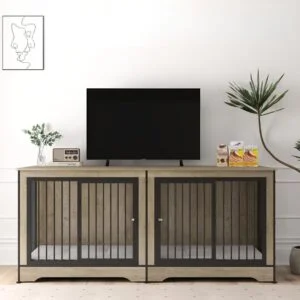Dog Crate Furniture
Showing all 11 resultsSorted by popularity
-
Price range: $115.50 through $189.99Select options This product has multiple variants. The options may be chosen on the product page
-
Original price was: $249.50.$209.50Current price is: $209.50.Select options This product has multiple variants. The options may be chosen on the product page
-
Price range: $125.51 through $172.85Select options This product has multiple variants. The options may be chosen on the product page
-
Original price was: $229.50.$189.90Current price is: $189.90.Select options This product has multiple variants. The options may be chosen on the product page
-
Original price was: $229.99.$184.00Current price is: $184.00.Select options This product has multiple variants. The options may be chosen on the product page
-
Original price was: $126.99.$99.99Current price is: $99.99.Select options This product has multiple variants. The options may be chosen on the product page
Showing all 11 resultsSorted by popularity
How to Buy a Decorating Dog Crate Furniture: Tips and Guides
Dog crate furniture is a pet crate that looks like a stylish piece of furniture. These decorative dog crates provide a safe space for your pet to retreat while also serving as functional end tables, side tables, or console tables to blend with your home decor.
Dog kennel furniture is often made of wood; Wooden dog crates are safe for well-behaved, crate-trained older dogs but are not suitable for teething puppies and dogs who have issues being in a crate.
When buying decorative dog crate furniture, start by determining what size dog crate you need. Choose a type and material that suit both your dog’s needs and your home’s style. Prioritize features that ensure your dog’s comfort and safety. Look for practical elements designed to make it easy to use and clean. Consider your budget, where to purchase, and whether custom-designed furniture better fits your space or your dog’s specific requirements.
What is Dog Crate Furniture?
Dog crate furniture is a multifunctional piece of furniture designed to serve as a comfortable and safe pet crate while doubling as a piece of furniture like an end table, side table, console table, or coffee table. Unlike traditional wire, plastic, or soft-sided crates, dog crate furniture blends seamlessly with home décor, offering a blend of fashionable and functional value for both pets and their owners.
Is Dog Crate Furniture Safe?
Dog crate furniture that has a waterproof, pet-safe coating is safe for crate-trained adult or senior dogs. A wooden dog crate is unsafe for stronger or anxious breeds and puppies who tend to chew through the materials.
Several safety concerns associated with furniture-style dog crates, and most of which are linked to their primary construction material—wood. While wood’s natural beauty makes the crate look nice and suitable for a variety of home styles and settings, it’s more vulnerable to chewing, splintering, and structural damage, particularly when used for high-energy or teething dogs. In addition, wood is porous and harder to sanitize because it absorbs moisture, traps odors, and harbors bacteria, which compromises both cleanliness and long-term hygiene.
Flimsy locking mechanisms, often found in wooden dog kennels, further contribute to the insecurity. Many of these crates rely on basic slide-bolt latches that can be unhooked or pushed open by clever escape artists.
What to Look for When Buying Dog Crate Furniture?
Buying the right dog crate furniture is an important decision that requires careful consideration to support your dog’s physical and mental well-being, complement the aesthetics of your home, and meet your needs. When selecting furniture-style dog crates, consider the appropriate size, the type and material of the crate that best suit your home’s layout, and features that offer both safety and convenience.
The six main tips to follow when buying your dog kennel furniture are listed below.
Determine What Size Dog Crate Furniture You Need for Your Dog
The right dog crate furniture size depends on your dog’s specific measurements and matching those measurements to the crate’s interior dimensions, not just breed or weight guidelines.
The right-sized dog kennel furniture allows your dog to walk into the crate without crouching down, fully stand up without banging their head on the ceiling, and comfortably turn around and lie down. Because dogs are den animals and prefer small den-like spots to rest, make sure the size is not too large. But a crate that is too small can lead to caged dog syndrome (CDS), resulting in anxious or destructive behavior such as barking, chewing, or digging.
To determine what size dog crate furniture you need, follow these five steps.
- Measure your dog for crate size. Have your dog stand on a flat surface, measure from the tip of the nose to the base of the tail (do not include the full tail length) to determine body length. Then, measure from the bottom of the paws to the top of the head or ears to determine height. Ensure your dog is standing straight with all paws flat on the ground and the back level for the most accurate reading. Use a soft, flexible measuring tape instead of a cold metal one, which may make noises, potentially scaring your dog.
- Add 3-4 inches to your dog’s measurements. If any measurement is too tight, size up to the next available size. Account for the type and thickness of crate mats you plan to use.
- Compare your dog’s measurements with the crate’s interior dimensions. Match your dog’s length and height to the interior dimensions of the crate, not the exterior. Decorative crates often have thick wood panels or built-in framing, which reduce the interior space available for your dog. If you base your purchase on exterior dimensions, you may end up with a crate that looks large, but your dog can’t actually fit inside comfortably. Always check the interior dimensions and compare them to your dog’s measurements before buying.
- Consider your dog’s behavior and growth. When purchasing a furniture-style dog crate for puppies, choose a crate that suits their adult size and use a divider panel to adjust the space as they grow. This not only saves money but also supports consistent crate training.
- Match the dog crate furniture to your space. Consider how the furniture-style crate fits within your room layout and complements existing furniture. This is more important for large or giant-breed crates. To ensure a good fit, measure the placement area and check door clearance, wall spacing, and nearby furniture.
There are four common dog crate sizes: medium, large, x-large, and xx-large. The chart below shows standard furniture-style dog crate sizes along with recommended dog’s size, weight, and breeds.
| Dog Crate Sizes (L x W x H) |
Dog Length | Dog Height | Dog Weight | Breeds |
|---|---|---|---|---|
| Small (22″ x 14″ x 16″) |
< 18 inches | < 14 inches | < 25 pounds | Chihuahua, Maltese, Yorkie, Pomeranian, Shih Tzu, Bichon Frise, Havanese |
| Medium (30″ x 20″ x 23″) |
< 28 inches | < 18 inches | 26 – 40 pounds | Beagle, French Bulldog, Boston Terrier, Corgi, Cocker Spaniel |
| Large (42″ x 28″ x 30″) |
< 36 inches | < 24 inches | 41 – 70 pounds | Boxer, Bull Dog, Cocker Spaniels, Bassett Hounds, Austrailian Shepherds |
| X-Large (48″ x 30″ x 32″) |
< 42 inches | < 28 inches | 71 – 90 pounds | Labrador Retrievers, Golden Retrievers, German Shepards, Rottweilers |
| XXL (51″ x 30″ x 45″) |
< 46 inches | < 30 inches | 91 – 110 pounds | Alaskan Malamute, Great Dane, St Bernard, Bernese Mountain Dog, Old English Sheepdog |
Choose the Type of Dog Crate Furniture
The type of pet crate furniture you choose depends on your dog’s size and where you plan to place it. There are five main types of dog crate furniture: end table, side table, console table, coffee table, and bedside table dog crate. Each furniture dog crate style is unique in its functionality, appearance, and size. These multi-functional pieces help save space and keep the home organized, especially in apartments or small homes.
The five main types of dog kennel furniture are listed below.
-
- Dog Crate End Table: End table dog crates double as a side surface placed next to a sofa or a chair. It typically has a compact footprint with decorative side panels and a flat top for holding lamps, books, or décor. Ideal for small to medium-sized dogs, it fits naturally into living rooms and reading nooks.
- Dog Crate Side Table: Side table dog crates are larger than end tables and often come with storages like drawers or shelves. They work well in hallways, entryways, or next to next to furniture where extra tabletop space is useful. This versatile style suits homes that favor transitional or classic aesthetics.
- Dog Crate Console Table: Console table dog crates have a long, narrow profile, making it perfect for placement along walls or behind sofas. It often accommodates larger breeds and includes decorative elements like cabinet-style doors or drawers above the crate section, adding utility while maintaining visual appeal.
- Dog Crate Coffee Table: Coffee table dog crates are low-profile crates that function as central pieces in living rooms. With a wide top and stylish base, they provide space for drinks, books, or décor, while the integrated crate below keeps your dog close to the heart of your home. These are best for dogs that enjoy social environments and lounging in shared spaces.
- Dog Crate Bedside Table: Bedside table dog crates combine crate functionality with bedroom utility. Placed beside your bed, they offer a safe sleeping area for your dog and a surface for nighttime essentials. This style is ideal for dog owners who want their pet nearby overnight while maintaining a clean, coordinated bedroom aesthetic.
- Dog Crate Bookshelf: Dog crate bookshelf are multi-functional furniture piece that combines an enclosed dog crate into the base of a bookshelf. The lower section serves as a pet crate for small or medium-sized dogs, while the upper shelves are used for books, decor, or storage.
Select the Best Dog Crate Furniture Material
Dog crate furniture is usually made of wood materials such as solid wood, medium-density fiberboard (MDF), and particleboard. Heavy-duty dog crate furniture add a metal frame for added strength, while custom designs are often made from hard wood. Some high-end crates combine wood with acrylic for a modern look.
Different wood type used in dog crate furniture has specific advantages and disadvantages in appearance, durability, hardness, and stability, which affect its function and price.
More information on each of the three wood materials used in wooden dog crates is below.
- Solid Wood: Solid wood like maple, oak, ash, or walnut, is known for its strength, durability, and natural texture, making it ideal for long-term use and high-end furniture designs. It provides excellent structural support, especially for large breeds. However, it tends to be heavier and more expensive, and may require sealing to prevent moisture absorption and warping.
- Particleboard: Particleboard is made from compressed wood chips and resin. It is the most budget-friendly option, but also the least durable. Particleboard is more prone to chipping, sagging, and absorbing moisture, which can shorten its lifespan, particularly if used in high-humidity areas or by dogs that chew or scratch.
- Medium-density Fiberboard (MDF): MDF is a cost-effective engineered wood product made from wood fibers and resin under higher pressure. It offers a smooth finish, is easy to paint, and resists cracking or splitting better than solid wood in some conditions. While not as strong as solid wood, MDF is the best alternative to real wood, especially when finished with a protective laminate or veneer. Keep in mind that MDF comes in different grades based on density, with higher grades offering better performance and aesthetics.
Consider the Appearance of The Dog Crate Furniture
When buying a piece of dog crate furniture, think about how it will fit into your space, not just in size and material, but in color and shape. Make sure the design complements your existing furniture, whether it’s placed in the living room, bedroom, or hallway. A well-designed crate should function as part of your décor, not stand out as an eyesore.
Wood dog crate furniture come in neutral colors like grey, brown, or beige. Grey finishes offer a clean, contemporary look and pair well with minimalist or urban decor. Brown tones, ranging from light oak to deep walnut, provide a warm, natural feel ideal for traditional, farmhouse, or industrial spaces. Beige or off-white crates create a light, airy aesthetic that complements coastal, boho, or modern farmhouse interiors.
Common shapes of dog crate furniture include rectangular, square, triangular, L-shaped, and I-shaped designs. L-shaped and corner crates are ideal for saving space and creating a cozy nook in small apartments.
Look Over Features for a Safe & Comfortable Dog Crate Furniture
When shopping for the best dog crate furniture, look for one that not only provides a safe space for your four-legged family member, but also keeps them comfortable. The level of safety of dog crate furniture refers to its strength and function to securely contain your dog without causing injury or allowing escape, especially when you cannot directly supervise them. A comfortable dog crate furniture means your pet feels physically and emotionally relaxed when they get confined. You should also keep the crate in areas where you and your family often hang out to make your dog feel less isolated and more comfortable.
Below is detailed information on five features that are needed for a safe and comfortable space when purchasing a wood dog kennel for your pooch.
- Wide Bar Spacing: Make sure the bar spacing isn’t large enough for your dog to get stuck in or escape through.
- Secure Latches: Opt for crates with dual locks that are positioned out of reach to prevent your pup from messing with the latches.
- Open or Enclosed Design. Choosing between open or enclosed crates depends mainly on your personality and behavior. Some dogs feel comfortable when they have a broad vision of their surroundings, but for other dogs, feeling anxious and stressed in open spaces. A good crate cover can make the space more comfortable and relaxing at night.
- Ventilation. Ensure that the crate provides adequate airflow for your dog to breath and keep your dog from overheating. Look for one that has slatted sides or open metal bars that promote airflow while allowing visibility. Poor ventilation can lead to overheating and anxiety, particularly in warmer climates or when the crate is placed in direct sunlight.
- Flooring. A supportive, comfortable crate base improves your four-legged friend’s well-being by offering proper support and ventilation. Avoid gridded or diamond-patterned flooring with large gaps, as these can trap paws or toes. Choose crate floors treated with polyurethane-coated for easier cleaning and better moisture resistance.
Look for Elements for a Convenient Dog Crate Furniture
Easy cleanup and ease of use are two important considerations when choosing convenient dog kennel furniture for your pup and lifestyle. Keep in mind that wooden dog crates are heavier than other types of dog crates, and can also be a pain to clean.
The eight standout elements that make a crate end table more convenient for everyday use are outlined below.
-
- Divider Panel: For pet owners with two dogs or a growing puppy, pick a dog crate table with a divider that allows you to adjust the crate space to fit a smaller dog and expand it as they grow, or keep two dogs safely separated within the same crate.
- Removable Trays: When choosing dog crate furniture, look for models that include removable trays or slide-out bottom panels. They make it easier to manage accidents, fur buildup, or spills, especially for puppies or older dogs. A plastic or metal tray liner beneath a slatted or grated floor can catch debris and be wiped down or washed separately, without having to move or disassemble the entire crate.
- Caster Wheels: If you plan to relocate the crate occasionally, consider models with caster wheels. They make it easy to move from room to room.
- Easy-Access Doors: Wide door openings, sliding or barn-style doors allow quick access during feeding, cleaning, or bedding changes. Some crates have dual doors or removable tops, which can be helpful if you have dogs with mobility issues.
- Self-close Mechanisms: These doors automatically swing shut and lock using magnetic or gravity-based systems, reducing the risk of escapes or accidentally leaving the door open.
- Integrated Storage: Crates with built-in storage compartments offer an added layer of convenience. Whether it’s a slide-out drawer or shelves, they help you keep dog essentials like leashes, toys, training pads, or treats within arm’s reach.
- Cable Management: For pet owners using crate-mounted cameras, fans, or heated beds, integrated cable management can prevent cords from becoming a tangle, or worse, a chew hazard. Some crate designs include built-in grommets, cord slots, or hidden channels that keep power cords out of reach.
- Non-Slip Feet & Base: Non-slip feet or rubberized base pads are essential to protect hardwood, vinyl, or tile flooring from scratches or scuff marks.
How Much Does a Dog Crate Furniture Cost?
Furniture style dog crates cost between $80 and up to $5,000. On average you can expect to pay between $150 and $700 for standard models. The cost of dog crate furniture varies greatly depending on size, materials, features, and craftsmanship.
Crates made from particleboard or MDF typically start around $80–$250, offering basic designs that blend into home décor without added elements like drawers, storage, or reinforced frames.
Mid-range models, usually priced between $300 and $500, often include solid wood construction, metal bars, removable trays, and dual functionality as end tables or console units. These options strike a balance between form and function—ideal for most crate-trained dogs in single-pet households.
At the high end, premium or designer furniture-style crates can cost $600 or more, featuring upscale finishes, handcrafted detailing, and multi-purpose use (e.g., TV stands, bookshelves, or credenzas). These crates are built to last and are designed to integrate seamlessly with luxury interiors.
If you’re looking for something tailored specifically to your dog’s size, behavior, or your home’s aesthetic, custom furniture dog crates are also an option. These are typically handcrafted to order using solid hardwoods, custom stains, and personalized dimensions. Prices for custom crates usually start around $800 and can exceed $5,000, depending on materials, complexity, and design specifications.
Are Furniture Dog Crates Worth It?
Furniture dog crates can be a worthy investment for pet owners who want to integrate a dog’s crate into their stylish home and still give their pup a safe and comfortable retreat. They are often worth it if you have a well-behaved, created-trained dog. Those with heavy chewers or escape artists may want to consider more durable options, such as full metal dog kennels or dog playpens.
Are Custom Furniture Dog Crates Worth It?
Custom furniture dog crates can be worth the investment as long as they fit your dog’s needs, your home’s layout, and your design expectations.
Custom crates are typically handcrafted to your exact specifications, allowing you to choose the dimensions, wood type, stain color, hardware finish, and functional features. This makes them ideal for pet owners with unique space requirements, large or odd-shaped dogs, or highly curated home interiors where standard crate designs clash with existing furniture.
Where to Buy Dog Crate Furniture?
The best places to purchase a dog crate end table or side table include Online Retailers such as Amazon, Chewy, Wayfair, Walmart and Lilly & Max. Direct-to-consumer brands like Fable, Fringe Studio, and ZenCrate specialize in modern, handcrafted, or multi-functional dog furniture. Some local pet retailers and custom furniture makers carry decorative dog crates or offer made-to-order options. Platforms like Facebook Marketplace, Craigslist, and OfferUp often feature gently used furniture-style crates at significantly reduced prices.
What Are The Most Popular Dog Kennel Furniture Brands?
Below is a list of ten brands that specialize in dog kennel furniture for indoor use.
- Fable
- Frisco (Chewy)
- Tucker Murphy Pet (Wayfair)
- Casual Home
- FEANDREA (Songmics)
- Merry Products
- New Age Pet (ECOFLEX)
- PawHut (Aosom)
- Richell USA
- Unipaws
- Crown Pet Products
- Denhaus
- Archie & Oscar (Wayfair)
- Castle Crates,
- Carolina Dog Crate Co. (Custom builders)
- Custom Woodworkers
- Big-Box
- Lilly & Max
Why Trust Lilly & Max Furniture Style Dog Crates?
Lilly & Max dog crate furniture is trusted for combining durability, safety, and style, giving your pet a secure space that also complements your home décor.
- Function-First Design: Built with your dog’s comfort and your convenience in mind.
- Premium Materials: Quality wood, reinforced panels, and non-toxic finishes for long-term use.
- Standout Features: Includes removable trays, dual doors, and smooth-close hardware.
- Stylish Options: Available in multiple sizes and finishes to fit any room or breed.
- Customer Approved: Backed by positive reviews for quality, appearance, and ease of use.
What Are Alternatives To Decorative Dog Crates?
Alternatives to decorative dog crates include heavy duty indoor kennel, indoor dog pen, and wire dog crates.
- Heavy duty indoor kennels are best for strong, anxious, or escape-prone dogs, these crates are reinforced for maximum security. They’re less decorative but highly functional.
- Indoor dog pens offer flexible confinement with more room to move. While not crates, they’re useful for supervised rest or short-term separation.
- Wire Dog crates are lightweight, foldable, and well-ventilated, ideal for crate training and portability. They’re available in multiple sizes and often include divider panels.












